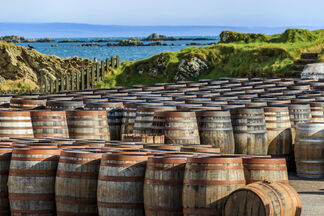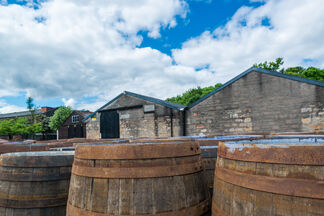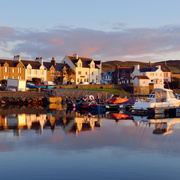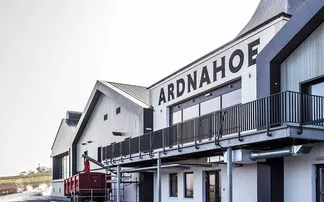The Islay Whisky Region Part 3
The Demise and Re-birth of Islay Distilleries
Whisky history has seen periods of high demand as well as downturns when distilleries had to close. The most recent downturn was in the 1980’s, but we now are clearly in a high-demand boom phase of the industry. Islay has lived through the ups and downs and has gone from a high of 23 distilleries, to a low of 6. The fairly recent openings/re-openings of Bruichladdich, Kilchoman and Ardnahoe have brought that number back up to 9. But more are coming! But many have also gone although they live on through stories, legends, names and buildings that are now in ruins or have found new uses. Read on to learn about the lost distilleries of Islay and the new ones coming to take their place.
The Lost Distilleries of Islay
A Real Treasure Hunt
Despite its small size, Islay has been home to many distilleries over the years. While several of them were short lived and their memories have faded, a few still linger on in stories, ruined buildings and place names. Making a bit of a whisky treasure hunt. If you go to Islay, and have time between visiting the big names, follow the trail laid out below and look out some whisky history – the lost distilleries of Islay. And spot the names that have been adopted as brand names of whiskies of the current 9 working distilleries.
List of the lost whisky distilleries of Islay
Ardenistiel
Founded in 1821, next door to Laphroaig and sharing its water source. The operation continued with some success until 1847, but the distillery then changed hands and none of the subsequent owners could keep it going – the final manager kept pigs on the nearby islet of Texa and used the malt kiln to smoke ham, but even that could not save Ardenistiel. By 1868 it closed and Laphroaig took over the site. The distillery’s derelict buildings became the site of Laphroaig’s current warehouses and offices.
Ardmore
Not to be confused with the Highland distillery of the same name - Ardmore was founded in 1817 and sat next door to Lagavulin. By 1825 they were both operated by John Johnston, and within 20 years the two distilleries were sold and merged to form the Lagavulin distillery we know today.
Daill
Was a farm distillery owned by the McEachern family founded in 1814. Not much is known about it, but by 1834 it had closed. Daill Farm still exists and a number of buildings on the estate could well have been used for distilling.
Lochindaal
Established in 1829 and was a purpose-built site in the middle of the village of Port Charlotte. Situated in the Rhinns of Islay, the western peninsula where Bruichladdich and Kilchoman are based today, it passed through many hands during its 100 years of operation. In the 1920s, its owners were acquired by the Distillers Company Limited, and the distillery was dismantled and eventually closed in 1929. The main buildings are now the site of the Islay Youth Hostel and a local garage, and the warehouses are used by nearby Bruichladdich.
Lossit
The Distillery was established in 1826 near to Ballygrant, just off the road between Bridgend and Port Askaig. It operated as a farm distillery until the 1860s, at which point it closed. While it’s thought that the distillery warehouses were used until at least 1867, today only the house and kennels remain.
Malt Mill
Perhaps the most legendary and famed of all closed Islay distilleries, Malt Mill also has one of the simplest stories. When Lagavulin owner Peter Mackie lost the sales agency for Laphroaig’s whisky in 1907, he decided to make his own Laphroaig. He built a small replica of his rival on-site at Lagavulin, but despite considerable effort, the whisky did not taste like Laphroaig and the project was a failure. However, the distillery survived until the 1960s, at which point the equipment was removed and integrated into Lagavulin – the Malt Mill building is now the visitor centre.
Mulindry
Established in 1826 and closed in 1831. Built by the River Laggan a few miles from Bowmore. The owner went bankrupt and emigrated to the USA amid rumours that he enjoyed his distillery’s whisky a little too much. Today, little remains of the site other than a derelict croft.
Newton
Was a farm distillery situated on the road from Bridgend to Ballygrant. Established in 1819, it operated until 1837, and little is known about the site. Today, Newton House still exists and has an outbuilding with barred windows that may have been used for bonded storage.
Octomore
Another farm distillery, established in 1816, but like many farm distilleries it didn’t last long, falling into disrepair by the 1940s. Today, some of the distillery’s buildings remain, and are now holiday cottages.
Scarrabus
Maybe situated near the site of the present-day Scarrabus farm, is almost certainly the shortest lived of the farm distilleries on Islay. Established in 1817, it had closed by 1818 and very little is known other than that a licence was issued for a single 76-gallon still.
Tallant
Founded in 1821 by Donald and John Johnston, the distillery was built at Tallant Farm near Bowmore. It was not a profitable operation and the business folded in 1852. However, it remains an interesting footnote in Islay’s distilling history, as the Johnston family also established Laphroaig.
The New Distilleries of Islay
Four new distilleries on the way
4 distilleries will open on Islay over the next few years to bring the number up to 13. Planned New Islay Distilleries include the revival of Port Ellen Distillery at the site of Port Ellen Malting. It is planned to open in 2024. I wrote about Port Ellen in Part 1 of The Isle of Islay. Here is some information about the other 3 new openings.
Portintruan Distillery is being built between Port Ellen and Laphroaig and will open in 2024. The distillery has been under discussion since April 2018 and has been known under its working title "Farkin Distillery" until it was named. It is owned by Elixir Distillers, a creator, blender and bottler of fine spirits, and is named after the former farm on which it will be built. The Gaelic name, which means „place of the stream", is pronounced Port-nah-truan. They will also produce rum.
The Islay Boys, owners of Islay Ales, will relocate their brewery to Glenegedale and build a whisky and rum distillery on the site as well under the name Laggan Bay Distillery. Planning permission has been granted. The Islay Boys are Mackay Smith and Donald MacKenzie, both originally from the Rhinns peninsula on Islay’s west coast, who established the business as an independent Scotch whisky bottling company in 2016. The first production date has yet to be announced.
The site of what will be a 13th Islay distillery, named IIi Distillery, is set to be located at Gearach Farm near Port Charlotte. It takes its name from the oldest name for Islay. No planning permission has been given for this distillery yet. Ili is the brainchild of landowner Bertram Nesselrode and farmer Scott McLellan, who are seeking a sustainable future for Gearach Farm. The aim is for the new “contemporary, sustainable distillery” to be “highly sustainable through the use of renewable energy, helping to ensure that Islay’s whisky legacy can continue well into the future,”
The future of Islay Whisky looks bright if you ask me. We can only hope that the unique character of the island itself will remain as it is today, and that Islay will not become a “Whisky Theme Park” of some sorts.




